The percentage of teens in high school (aged 16 or older) who drove when they had been drinking alcohol decreased by 54 percent between 1991 and 2011, according to a Vital Signs study released today by the Centers for Disease Control and Prevention.

Research has shown that factors that help to keep teens safe include parental involvement, minimum legal drinking age and zero tolerance laws and graduated driver licensing systems.
Nearly one million high school teens reportedly drove when they had been drinking alcohol in 2011. These teens were responsible for approximately 2.4 million episodes of drinking and driving a month, meaning that some engaged in the dangerous behavior more than once a month.
Drinking and Driving Deadly for Teens
Fewer teens are drinking and driving, but this risky behavior is still a major threat.
- Drinking and driving among teens in high school has gone down by 54 percent since 1991. Still, high school teens drive after drinking about 2.4 million times a month.
- 85 percent of teens in high school who report drinking and driving in the past month also say they binge drank. In the survey, binge drinking was defined as having 5 or more alcoholic drinks within a couple of hours.
- 1 in 5 teen drivers involved in fatal crashes had some alcohol in their system in 2010. Most of these drivers (81 percent) had BACs higher than the legal limit for adults.
Preventing Teen Drinking and Driving: What Works
- Minimum legal drinking age (MLDA) laws in every state make it illegal to sell alcohol to anyone under age 21. Research has shown that enforcement of MLDA laws using alcohol retailer compliance checks has reduced retail sales of alcohol to those under the legal drinking age.
- Zero tolerance laws in every state make it illegal for those under age 21 to drive after drinking any alcohol. Research has demonstrated that these laws have reduced drinking and driving crashes involving teens.
- Graduated driver licensing (GDL) systems help new drivers get more experience under less risky conditions. As teens move through stages, they gain privileges, such as driving at night or driving with passengers. Every state has GDL, but the specific rules vary. Research indicates that GDL systems prevent crashes and save lives.
- Parental involvement, with a focus on monitoring and restricting what new drivers are allowed to do, helps keep new drivers safe as they learn to drive. Parents can consider creating and signing a parent-teen driving agreement with their teens. Research has shown that when parents establish and enforce the “rules of the road”, new drivers report lower rates of risky driving, traffic violations, and crashes.
Source: Centers for Disease Control and Prevention
Was this article valuable?
Here are more articles you may enjoy.


 Rare Weather Warning Issued as Strong Gusts Fuel Colorado Wildfire Threats
Rare Weather Warning Issued as Strong Gusts Fuel Colorado Wildfire Threats  Flooding in California Leads to Soaked Roads, Water Rescues and 1 Death
Flooding in California Leads to Soaked Roads, Water Rescues and 1 Death  Tata Steel Says NGO Seeking $1.6B for Alleged Health Damage
Tata Steel Says NGO Seeking $1.6B for Alleged Health Damage  Instacart to Pay $60 Million in FTC Consumer Protection Case
Instacart to Pay $60 Million in FTC Consumer Protection Case 